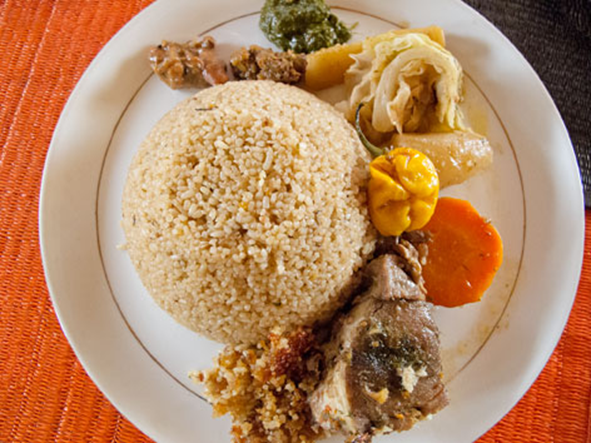When it comes to the vibrant culinary traditions of West Africa, Senegal stands out for its rich and diverse flavors. Among the country’s most beloved dishes is Ceebu Jën, a tantalizing combination of fish and rice that showcases the essence of Senegalese cuisine. Bursting with aromatic spices, fresh ingredients, and a symphony of flavors, Ceebu Jën has become a symbol of Senegal’s culinary prowess.
Ceebu Jën, which translates to “rice and fish” in the Wolof language, is a one-pot dish that brings together the staple foods of Senegal: fish and rice. At its core, Ceebu Jën is a celebration of the country’s abundant coastline and the bountiful fish found in its waters. The dish traditionally features whole fish, such as red snapper or grouper, which is marinated and then gently simmered with vegetables and aromatic spices.
The preparation of Ceebu Jën is a labor of love, requiring patience, skill, and attention to detail. To begin, the fish is cleaned, seasoned with a blend of spices such as garlic, ginger, and thyme, and then left to marinate for a short period to infuse the flavors. Meanwhile, a flavorful broth is created by simmering onions, tomatoes, carrots, and other vegetables in a fragrant blend of herbs and spices, including the quintessential Senegalese spice mix known as “thiébou yapp.”
Once the broth is prepared, the marinated fish is gently added to the pot, allowing it to simmer and absorb the flavors of the broth. As the fish cooks, it releases its own savory juices, further enhancing the depth of flavor. The result is tender, succulent fish infused with a medley of aromatic spices.
But Ceebu Jën is not complete without the rice. The fish and broth are then removed from the pot, and the rice is added to the remaining liquid, allowing it to cook and soak up all the delicious flavors. The rice is often seasoned with a vibrant orange-red palm oil, which not only adds a distinctive color but also imparts a unique taste to the dish. The cooked rice is served alongside the fish, accompanied by a variety of sides and condiments, such as vegetables, pickles, and a fiery pepper sauce called “sauce piment.”
The beauty of Ceebu Jën lies in its versatility and adaptability. While fish is the traditional centerpiece, variations of the dish can be found featuring other proteins, such as beef, lamb, or poultry, catering to different tastes and dietary preferences. Additionally, the choice of vegetables and spices can vary depending on regional influences and personal preferences. This versatility allows Ceebu Jën to be a customizable dish that reflects the diverse culinary landscape of Senegal.
Ceebu Jën not only delights the palate but also offers a wholesome and nutritious meal. The combination of fish and rice provides a good balance of proteins, carbohydrates, and essential nutrients. The inclusion of vegetables and aromatic spices further enhances the nutritional profile, making Ceebu Jën a satisfying and well-rounded dish.
Beyond its gastronomic appeal, Ceebu Jën holds cultural significance in Senegal. It is often prepared for special occasions and gatherings, symbolizing unity, generosity, and hospitality. Sharing a communal plate of Ceebu Jën is a cherished tradition that brings family, friends, and communities together, fostering a sense of togetherness and celebration.
As Senegalese cuisine gains recognition and popularity worldwide, Ceebu Jën has become a beloved ambassador of the country’s culinary heritage. Senegalese restaurants and food enthusiasts around the globe have embraced this flavorful delicacy, introducing it to new audiences and showcasing the culinary treasures of West Africa.
In conclusion, Ceebu Jën represents the heart and soul of Senegalese cuisine. Its captivating flavors, vibrant colors, and cultural significance make it a standout dish that exemplifies the rich culinary traditions of the region. Whether enjoyed in Senegal or savored in international settings, Ceebu Jën is a testament to the diversity and beauty of West African cuisine.








